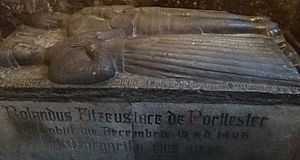Rowland FitzEustace, 1st Baron Portlester facts for kids

Rowland FitzEustace, 1st Baron Portlester (born around 1430 – died December 19, 1496) was an important Irish noble, a government leader, and a judge. He was one of the most powerful people in Ireland during the late 1400s. Only his son-in-law, Garret FitzGerald, known as the "Great" Earl of Kildare, had similar influence.
Contents
Rowland's Early Life and Career
Rowland FitzEustace was the oldest son of Sir Edward FitzEustace of Castlemartin, County Kildare. His mother was Alicia. His family was one of the most important "Old English" families living in the Pale. The Pale was a small area around Dublin that was under English control.
Around 1454, Rowland became a lawyer in England. Soon after, he became a main administrator for the top courts in Ireland: the King's Bench and the Common Pleas. In 1474, King Edward IV of England made him the Lord Chancellor of Ireland (a chief legal advisor) and the Lord Treasurer of Ireland (in charge of the country's money). In 1462, he was given the noble title of Baron Portlester.
Challenges and Influence
In 1462, Rowland was accused of serious wrongdoing, but he defended himself so well that the accusations were dropped. Similar accusations against him in 1470 also went away. In 1474, he helped start the Brotherhood of Saint George. This was a military group created to protect the Pale, which was the only part of Ireland truly controlled by England.
In 1478, Rowland's son-in-law, Gerald FitzGerald, 8th Earl of Kildare, was replaced as the King's main representative in Ireland by Lord Grey. Rowland then led a campaign to make it difficult for Lord Grey to do his job. Lord Grey asked Rowland to hand over the Great Seal of Ireland, which was a special stamp used to make official documents legal. But Rowland refused. This made it impossible for the government to get anything done.
King Edward IV tried hard to support Lord Grey. He even ordered the Master of the Royal Mint (where coins were made) to create a new Great Seal. The King said that the seal Rowland had was no longer valid. But Rowland's actions were so effective that Lord Grey had to return to England after only a few months.
Later Years and Family
King Edward IV reappointed Rowland as Chancellor. When Henry VII became king in 1485, he kept Rowland in his position. However, Rowland was later removed because he supported Lambert Simnel. Simnel was a young boy who pretended to be King Edward VI of England. Simnel was crowned in Christ Church Cathedral, Dublin in 1487, with almost all the Irish nobles taking part. Simnel then invaded England with an Irish army, but they were defeated at the Battle of Stoke.
King Henry VII was forgiving after his victory. He spared Simnel's life and pardoned Rowland and the other nobles. But he decided to divide Rowland's important jobs between Alexander Plunket and Sir James Ormond. Even so, Rowland remained a powerful figure for the rest of his life. In 1493, he successfully defended his actions as Treasurer when they were questioned.
Rowland's Family Life
Rowland FitzEustace was married three times. His wives were:
- Elizabeth Brune
- Joan (or Jenet) Bellew, whom he married in 1463
- Margaret (or Marguerite) d'Artois, whom he married after 1467. This marriage brought him much more land.
Rowland had children with all his wives, but it's not always clear which wife was the mother of each child. His only legitimate son, Richard, died when he was young.
His daughters included:
- Alice, or Alison (died 1495), who married Gerald FitzGerald, the 8th Earl of Kildare.
- Joan, who married two times.
- Jenet, who married Sir Walter Delahide. Jenet and her sons were involved in a rebellion led by the Earl of Kildare's grandson, Silken Thomas, and faced serious consequences.
- Margaret, who married Christopher Rochfort.
- Maud, who married Thomas Marward.
- Katherine, his second daughter with Margaret d'Artois. She was made legitimate by a special law passed by the Parliament of Ireland in 1475-76.
He also had a son named Oliver FitzEustace, who became a chief judge in the Irish financial court. Because Oliver needed help with his duties, his father appointed others to act for him.
When Rowland died in 1496, his noble title of Baron Portlester ended. However, his nephew Thomas, who was his brother Richard's son, was given the title of Viscount Baltinglass in 1541. Later, Sir Maurice Eustace, another important member of the FitzEustace family, was offered the title Baron Portlester but decided not to take it.
Rowland's Legacy
Historians like Elrington Ball believed Rowland FitzEustace was perhaps the most important Irish political figure of his time. He was even more influential than his famous son-in-law, the "Great Earl of Kildare."
Memorials
There is a memorial to Rowland and his third wife, Margaret d'Artois, in St. Audoen's Church in Dublin. He built it to show thanks for surviving a shipwreck near the church. He also founded New Abbey in Kilcullen, where he is buried next to his daughter Alison. His lands went to his nephew Thomas Eustace, 1st Viscount Baltinglass.
Images for kids
-
This is a stone carving of Rowland FitzEustace (top) and his third wife, Margaret d'Artois (bottom). You can find it in St. Audoen's Church in Dublin.


